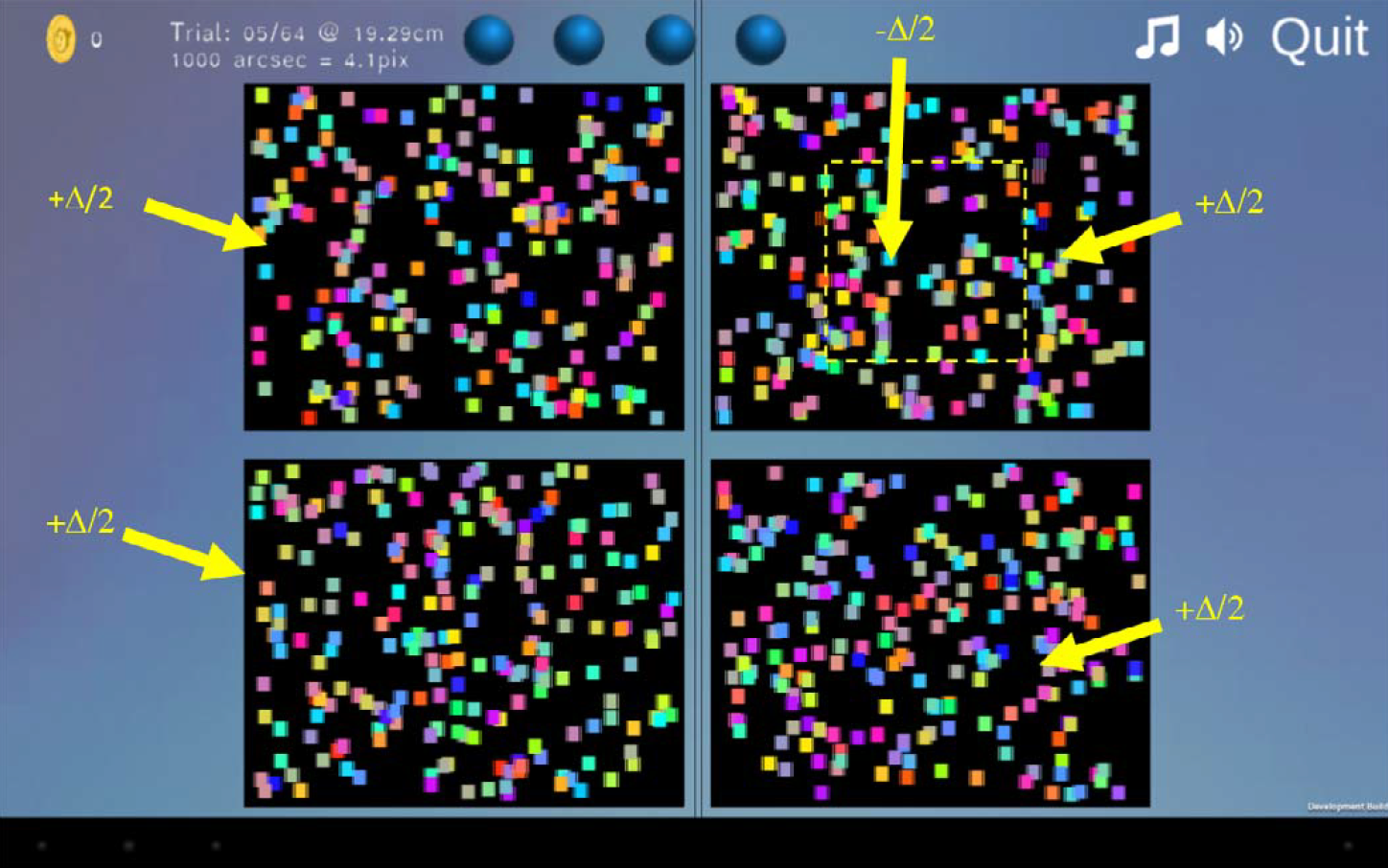 |
| Screenshot showing the tablet-based Asteroid test stimulus, with four patches of random-dot patterns. The top right patch contains a target region perceived by the patient to be in front of the screen. Photo: Vancleef K, et al. Trans Vis Sci Tech. 2019;8(1):25. Click image to enlarge. |
Stereoacuity testing is a workhorse of the standard vision exam and all optometrists are comfortable with their assessment technique. However, a range of clinical tests exist to choose from and the question of reliability/repeatability may give a clinician pause. Varying greatly in aspects of test design, range of disparities measured, monocular cue presence and method of presenting disparate images, these tests may be chosen by practitioners based on robustness of measurements in terms of sensitivity, specificity and test-retest variability.
New research has aimed to compare the test-retest variability of four different stereoacuity measures since data is limited on newer tests and how the compare to more commonly used ones. Included for analysis were the TNO, Frisby, Lang Stereopad and Accurate STEReotest On a mobIle Device (Asteroid) tests, in which stereoacuity was measured twice for each one.
The study included 54 adults (31 female, 23 male) ranging in age from 18 to 72. Study researchers found all test-retest variability to be insignificant except for the Lang Stereopad test. The Asteroid test yielded the smallest variation between repeated measures, but the Frisby resulted in the narrowest and Lang Stereopad the widest limits of agreement. Biggest mean bias was observed between Frisby and Lang Stereopad when comparing results between tests, 64.8% and 31.5% of differences fell into medium and larger ranges, respectively.
Overall, the TNO and Frisby tests showed good reliability but measured stereoacuity over a narrower range than the Asteroid test, which had less variation with repeated testing but a larger testing range. Test-retest analysis confirmed Asteroid had the smallest mean bias, followed by Frisby then TNO, indicating Asteroid to be least variable with repeated use.
The wider limits of agreement seen with the Asteroid and Lang tests are hypothesized to be due to the larger range of stereoacuity that can be measured, with Asteroid at 999” of arc and Lang at 750”, compared with narrower 580” in Frisby and 465” with TNO.
Finally, the authors discuss the large proportion of participants (59%) that displayed medium differences (21-100” of arc) in stereo measurements between TNO and Asteroid. Once again, this difference may be the result of the range measured by each test, since TNO and Frisby have narrower testing ranges than Lang Stereopad and Asteroid. Another contributor may be the mode of presentation, like with dot size, static or dynamic random dots.
When deciding what test to choose, the authors explain in their article for the journal Strabismus that “standard clinical tests, TNO and Frisby have good reliability but cannot be used interchangeably. Therefore, stereotest selection for patients should remain constant between visits.”
Further elaborating, the researchers conclude that “the Asteroid had good reliability and compared well with the TNO in adults with good visual acuity. However, further evaluation of these tests is required to determine reliability in larger cohorts in patients with impaired stereoacuity and in older adults with normal visual acuity and binocular vision.”
Mehta J, O’Connor A. Test retest variability in stereoacuity measurements. Strabismus. September 13, 2023. [Epub ahead of print]. |

